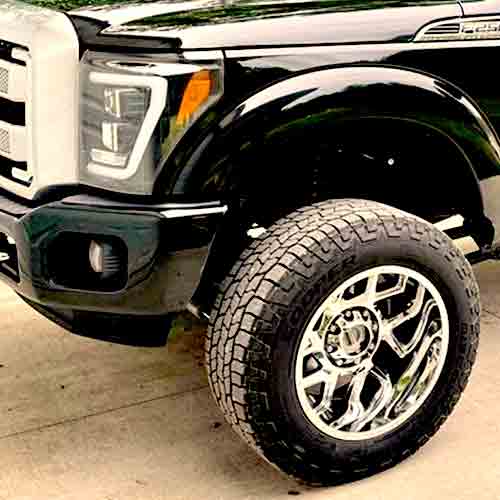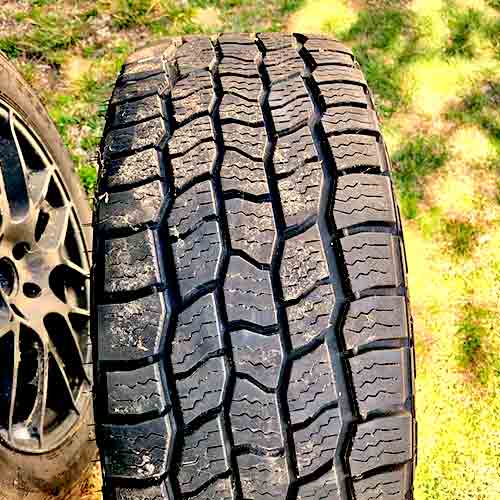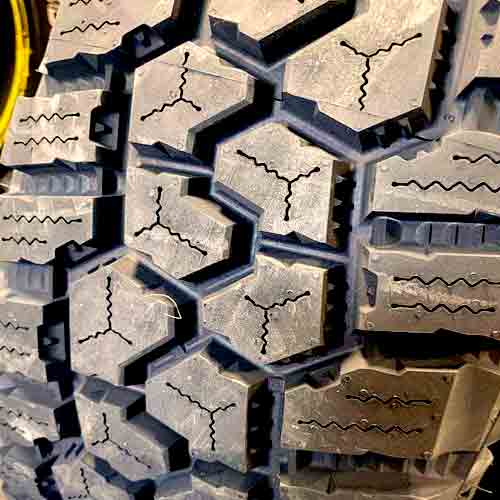Both of these tires are although all-terrain, they are sub-categorized in to different channels. The Cooper Discoverer Rugged Trek is considered a hybrid, carrying mud-terrain like shoulders, where the Cooper AT3 is a good old, all-terrain tire. Though besides being so different, both of these tires offer a great balance of performance and comfort. So which one is better for you? Well lets find out!

Sizes Info
So the Cooper Discoverer AT3 (considering XLT variant), comes with 32 sizes in 15 to 20 inches rims, having following specs.
- They have speed ratings of either R or S.
- Load range: C to F.
- Weight range: 44 lbs to 70 lbs.
- Tread depth is seen to be either 16.5 or 17/32″ in all sizes.
- All sizes have 60k miles warranty.
Detailed Review of Cooper AT3 XLT: https://tiredriver.com/cooper-discoverer-at3-review/
While the Cooper Rugged Trek only offering 18 sizes (in 16 to 20″), comes with following specs.
- All have speed ratings in either T or Q.
- Load rating: SL, XL, E and F.
- Tire weight goes form 40 lbs to 70 lbs.
- Tread depth: Either 16/32″ or 18.5/32″.
- LT sizes have 55k miles warranty, while others have 65k.
Both tires have 3PMSF and M+S winter ratings.
Tread Design
Starting with Cooper Discoverer AT3, this tire comes with traditional 5 rib structure.

The 3 ribs in the middle form 4 zigzag longitudinal channels, where the outer ones (along with shoulders) are relatively wider.
All these ribs have lugs (in pairs, joined up with each other with connectors, underneath).
These squared-off blocks feature full depth wave-like sipes, and off-set edges, and their lateral gaps act as in-groove biters.
The shoulder lugs are a little bigger, though they carry similar features, like sipes, foundational supports, and connectors in between.
But yes, they also have snow vices facing the lugs in the middle.
Furthermore, these shoulder blocks have staggered margins (with mud scoops), and they form thick sidewall lug
Note: The sidewall lugs are the main features which differentiates the Cooper AT3 XLT, from the Discoverer LT and the Discoverer AT3 4S (review).
The Cooper Rugged Trek on the other hand is much more aggressive.

It’s central pattern consist of interlocking lugs with wider tread voids.
All these lugs carry Y shaped interlocking (full depth) sipes, sharp edges, notches and reinforced foundations.
Moreover they also carry snow vices facing the shoulder blocks.
Speaking of which, shoulder blocks are elongated, and have more biting edges (where prominent notches are off-sets are seen).
They are also staggered/serrated, where they form thicker mud scoops compared to AT3.
Moreover, you also get dual sidewall lugs on this tire as well, which are again thicker compared to it’s little brother.
Pavement Performance
Assessing the dry performance of an all-terrain tire necessitates an evaluation of its traction, steering, and cornering attributes. Let’s talk about them one by one.
Directional Grip
Directional grip, examines a tire’s performance on straight roads, that’s why it gets calculated by braking distances and acceleration times.
And as, when a tire’s run straight, its central tread connects with the road more firmly it makes sense why out of both tires here, the Cooper Discoverer AT3 gets to be better, showing up 5 feet shorter braking efficacy.
Besides having more densely packed lugs there, it also features longitudinal alignment of these blocks, along with reinforced foundations underneath them. So you get superior grip combined with stability.
In contrast, the Cooper Discoverer Rugged Trek, with its chunky design and widely spaced lugs, falls short here.
Lateral Traction
Lateral traction, essential for cornering, hinges on the connection between the outer shoulder lugs of the tire and the ground. This is because, as the tire turns, the vehicle’s entire weight shifts there, due to inertia.
And so given the wider grooves on its shoulders, the Cooper Discoverer Rugged Trek performs less impressively in this aspect.
Conversely, the Cooper AT3, features packed up shoulders having strong connectors in between, allowing for greater lateral g-forces and superior handling times.
Handling Response
The overall responsiveness indicates how promptly a tire reacts to steering inputs, a factor largely influenced by the tire’s overall weight and structure.
And so the Cooper Rugged Trek’s lacking performance here can be explained by its greater tread depth, and aggressive shoulder pattern.
Both of these factors basically allow for greater lug bending as the tire corners, resulting in a less reliable balance between under and over steering, which of course results in slower feedback.
The Cooper Discoverer AT3 on the other hand, keeps its lug to road connection firmer, giving you a more direct steering.
Wet Performance
Achieving solid traction on wet roads hinges on the interplay between siping and flexibility. This is because sipes are slits which contract/expand to create suction for water particles, coming underneath. And so besides needing ample of these slits, they must also be “flexible” enough.
Given this, it is expected that the Cooper Discoverer Rugged Trek, is a lacking tire here, with fewer sipes, having a stiffer rubber composition.
On the flip side, the Cooper AT3 not only features a higher number of sipes, but they have better structure to them as well, along with tread flexibility.
This tread flexibility also account for superior hydroplaning resistance, as it creates (a better) negative pressure for the water, as it gushes out of the grooves at a faster rate. So you get better float speeds on both curved and straight aqua tests.
Fuel Efficiency
Although the difference in fuel economy is pretty low, when comparing these tires, it still adds up to a lot in the long run. So its still very crucial.
So let me explain why, Cooper Discoverer AT3 comes out better here, despite both tires having similar weighing sizes (on average).
The tire for one, has longitudinally aligned lugs, which roll with more ease.
And with closed up tread voids, lugs aren’t pressed against the road with as much pressure. So less rolling resistance gets generated.
Moreover, with shallower tread depth, all its lugs don’t face as much flexing, with the tire cornering, or braking, so minimum amount of energy gets wasted.
Contrarily, the Cooper Discoverer Rugged Trek, with its wider grooves, exerts more pressure on each lug (as the weight is distributed over fewer blocks). And its unsupported lugs flex during turns, braking, and acceleration, wasting energy and consequently consuming more fuel.
Comfort
Two main factors contribute to overall ride comfort, tread noise and bump absorption, and the Cooper AT3 excels in both.
Noise generation is tied to the tire’s tread design, the balder the tire, the more air particles ricochet, creating noise. Hence, the Cooper Discoverer AT3, with its compact design, prevails in this regard.
Moreover, thanks to its softer compound compared to the Cooper Rugged Trek, it also get to be superior in absorbing road imperfections, further enhancing the comfort of the ride.
Winter Performance
In snowy conditions, all-terrain tires (for the most part) carry/or try to carry, winter tire characteristics, employing a softer rubber, slimmer profile, and abundant biters.
These design elements aim to capture snow particles and lodge them in the grooves to facilitate snow-to-snow contact (as snow sticks more with each other, compared to rubber).
And considering that, I must say, you can’t go wrong with either one of these tires here, both of which have 3 Peak Mountain Snowflake (3PMSF) ratings.
Both tires sport a narrower design and provide an array of biters, including snow vices and interlocking sipes all over the tread.
Sand Traction
Optimum traction on sandy terrain necessitates tires to have maximum flotation and minimal digging abilities, which explains the common practice of reducing air pressure on this soft terrain type.
And here the Cooper Rugged Trek takes the lead with its dual sidewalls.
Although both tires get to have similar weighing structures, the Cooper AT3 with smaller sidewall lugs, still isn’t able to produce as much contact patch with the sand, with reduced air pressure.
Gripping on Mud
On mud you need two things, faster evacuation and momentum, and both of these are better on Cooper RT.
The tire has bigger mud scoops combined with elongated sidewall lugs, which paddle its way out of the thick mud with no trouble.
And it’s much wider tread voids, and interlocking central lugs, with bold stone ejectors, provide superior mud cleaning in all directions.
Conversely, the Cooper AT3 struggles with its circumferential ribs, mostly hindering sufficient mud evacuation, through sideways.
Climbing Rocks
Climbing rocks demands biting abilities from all directions and robust internal and external construction, in tires.
And Cooper Rugged Trek shines in both.
If I talk durability first, yes sure, it has 2 ply sidewalls just like its little brother, but the thicker lugs on top, still provide slightly greater toughness to the tire, nonetheless.
And in terms of biters, it’s interlocking lugs are much better in providing multi-angled grip too.
Moreover, its dual sidewall lugs, further add to its overall gripping efficacy, with lowered air pressure, as they get to flex better, and provide (relatively) larger footprint with the rocky surface, compared to Cooper Discoverer AT3.
To Sum Up
Both tires display impressive performance in various conditions, each having its unique strengths and weaknesses.
The Cooper AT3 shines on pavements, in terms of fuel economy, tread life and comfort. And you get a much better steering response, directional grip and lateral traction with this tire on both, wet and dry environments.
On the other side, the Cooper Rugged Trek offers greater self cleaning grooves, allowing for better mud traction. And its dual sidewall lugs supply much better rocky and sandy terrain traction as well.
Though both tires show up with similar performance values when it comes to winter performance.
Why all the hate on the rugged treks?
I apologize if the content seemed biased against the Cooper Discoverer Rugged Trek. It is not my intention to spread hate but to provide an unbiased review based on various factors including performance, durability, and user feedback. Though, I appreciate your feedback.
Ozmen. No need for an apology nor did you seem biased against the Cooper Discoverer RT. This is my second reading of your tire reviews: excellent and objective advice. Keep up the great reviews.